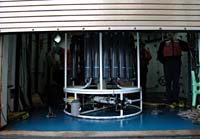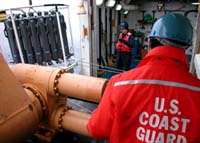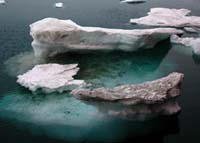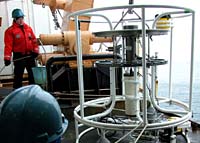|
|
 |
 |
 |
|
The CTD is kept in a heated garage in between casts to prevent the sensors from freezing up. |
|
Click to enlarge |
 |
|
Deploying the CTD: Patty McDonald (foreground) controls a line while Paul Rodriguez (background) directs the winch. |
|
Click to enlarge |
 |
|
The water carves the ice into fascinating shapes. |
|
Click to enlarge |
 |
|
With the Niskin bottles removed, the CTD frame looked almost “naked” to us. |
|
Click to enlarge |
Daily Update
Calendar
Dispatch 23 - August 6, 2002
By C.A. Linder
Weather conditions: intermittent drizzle, overcast skies, winds 10 knots from the SW, calm seas, air temperature 32° F.
Icing on the Icing
To say that this cruise has been a success would be an understatement. Over lunch, I talked with Principal Investigators Tom Weingartner and Bob Pickart about how they thought everything had been going so far. They were ecstatic. “If we had simply put in the moorings, the cruise would have been a success” Tom stated. “To be able to do these Barrow Canyon CTD stations in addition to the moorings is the icing on the cake” added Bob. Click here for a map that shows the water depth and the three Barrow Canyon CTD sections. In the past couple of days we have been sampling with the CTD as fast as we can. We’re making full use of our remaining few days before we have to turn south and head home. Having finished sections across Barrow Canyon (shown by green line on map) and west of the canyon (blue on map), we have now turned east in an attempt to finish a third section across the mouth of the canyon (red on map). If the last section was icing on the cake, this is the icing on the icing.
We have had our fair share of equipment failures today, though. The first casualty was the Niskin bottle firing mechanism. We were faced with a bit of a tough decision - spend 3-4 hours replacing the bottle firing system and possibly not complete the section, or finish the section without nutrient and salinity sample analyses. We decided to press on, sacrificing the water samples. Then, bottles started randomly closing while the CTD was still on deck! This can be a potentially very expensive problem - if an empty Niskin bottle is brought down to depth it can implode from the intense pressure. This can cause adjacent instruments to shatter - in other words, a very very bad thing. So, off came the bottles. Everyone maintained a jovial spirit, though - after all, tomorrow we would be headed home.
A final disappointment today was the loss of our 24 hour email and internet connectivity, which everyone had greatly enjoyed up to this point. We are now limited to two one-hour connection windows per day. After 22 days of being able to hear from friends and loved ones at any time of day and even keep up with local news, it’s a blow to morale. However, when you consider that we’re at sea in the Arctic Ocean, one of the most remote places on earth, it’s a technological marvel that we can communicate with the outside world at all!
 Previous Dispatch
Next Dispatch Previous Dispatch
Next Dispatch

Back to Calendar
|
|




